Reducing CO2 emissions in response to climate change,
promoting the use of renewable energy, and so forth
Basic concepts
Recognizing the risk of climate change as our Group’s greatest risk, we will encourage the incorporation of energy-saving vehicles (trains and buses) and the use of renewable energy to promote a modal shift, and expand the certificate acquisition and development of green buildings.
Reducing carbon emissions and saving energy and resources
Achieving Carbon Neutrality by 2050
The Group has set a goal of reducing CO2 emissions by 46% or more by FY2030 compared to FY2013. Emissions for FY2023 were 214,394 tons, which is a 30.8% reduction when compared to 309,902 tons in the base year of FY2013.
We will continue to introduce energy-efficient vehicles as well as energy-efficient equipment in our real estate and distribution facilities to achieve the goals of the "Nankai Environmental Vision 2030." The Group has set a target of practically zero CO2 emissions by 2050, and will consider and enact all possible measures, including not only ways to conserve energy, but also the introduction and utilization of renewable energy, energy creation, and alternative energy, and the use of carbon offsets.
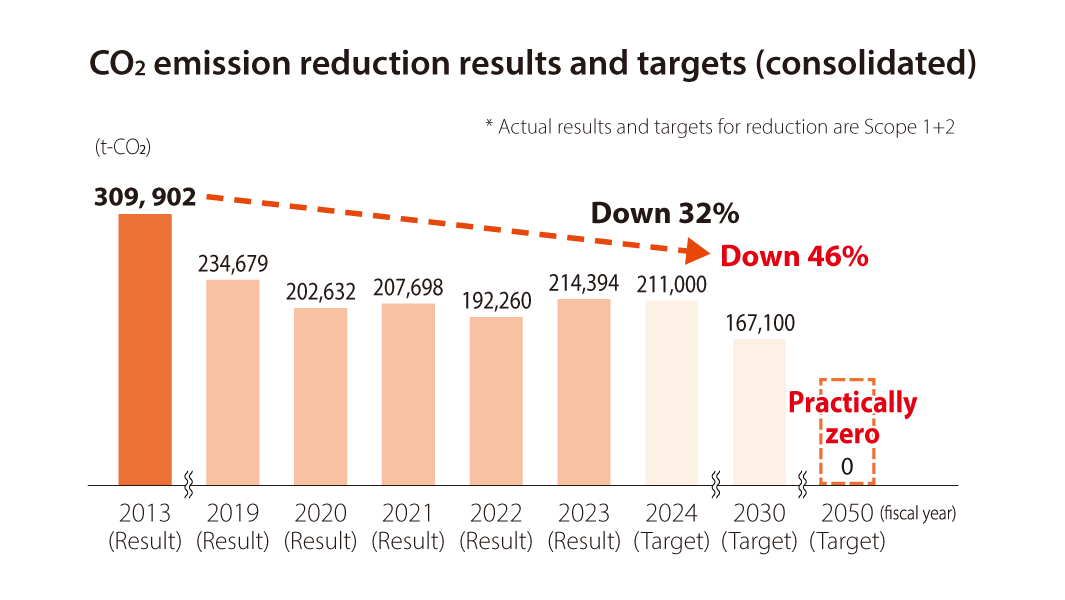
Supporting recommendations from the Task Force on Climate-related Financial Disclosures (TCFD)
We have set "reducing climate change" as part of the Nankai Environmental Vision 2030 and are implementing measures to save greenhouse gas emissions.
The average temperature has risen worldwide, causing extreme high temperatures and more frequent rainfalls and floods and creating what we can call a climate crisis. In view of this, we have launched initiatives to enhance our risk management while incorporating the projected impact of climate change on our businesses, and incorporating the measures into our business strategy. In September 2021, we agreed to the recommendations of the Task Force on Climate-related Financial Disclosures (TCFD)* that aims to reduce the risk of the financial market being destabilized by climate change.

*Established in 2015 by the Financial Stability Board, an international organization. It advises companies on how to evaluate their own business risks and opportunities caused by climate change, to understand the financial impact, and to disclose relevant information.
Obtained third-party assurance for environmental impact data
In order to improve the reliability of our environmental impact data, the Group has been obtaining third-party assurance for energy-originated CO2 emissions (Scope 1 and 2) since FY2021. In FY2022, we also obtained third-party assurance for the Nankai Group Energy-Originated CO2 Emissions Calculation Report (FY2022) from Deloitte Tohmatsu Sustainability Co., Ltd.
April 28, 2023 third-party assurance report (PDF:2,285KB)
Understanding CO2 emissions through the supply chain (Scope 3)
In addition to CO2 emissions (Scope 1 and 2) from the business activities of the Group, we have also calculated the results of indirect emissions (Scope 3) generated in the supply chain from FY2021. In the last three years, purchased goods and services have accounted for about 60%.
Scope 3 CO2 emission data by category (FY2023 results)
(Unit: t-CO2)
| Upstream (Procurement) | 1. Products and services purchased | 495,948 | Downstream (Sales) | 9. Transportation, shipping (downstream) | – |
|---|---|---|---|---|---|
| 2. Capital goods | 100,206 | 10. Processing of products sold | – | ||
| 3. Fuel and energy related activities not included in Scopes 1 and 2 | 38,255 | 11. Use of products sold | 18,892 | ||
| 4. Transportation, shipping (upstream) | – | 12. Disposal of products sold | – | ||
| 5. Waste from business | 9,667 | 13. . Leased assets (downstream) | 134,680 | ||
| 6. Business trips | 1,159 | 14. Franchises | – | ||
| 7. Employee commuting | 2,117 | 15. Investment | – | ||
| 8. Leased assets (upstream) | – | Total | 800,925 | ||
* Supply chain: A series of processes involved in the procurement, manufacture, logistics, sale, and disposal of products and other goods in business activities.
* Categories 4, 8, 9, 10, 12, 14 and 15 are excluded from importance.
* Not guaranteed by any third party
Energy-saving measures taken in railway facilities and train cars
The electricity consumption of our railways in FY2023 was 212,482,000 kWh (an increase of 0.6% compared to FY2022). Of this, the amount used for operations was 185,296,000 kWh, accounting for 87.2% of the total amount, and the remaining ancillary electricity consumption was 27,186,000 kWh. Overall, the electricity consumption for railways decreased by 11.4% in FY2023 when compared to FY2013. Ancillary electricity is energy used for signal equipment, railroad crossings, and station facilities (lighting, air conditioning, elevators, etc.). We have been making efforts to save energy, such as saving energy during summer and winter months (strict adherence to room temperatures, etc.) and changing station light fixtures to LEDs.
Regenerative braking and VVVF control
VVVF control is the control of AC motors through voltage and frequency variation to determine train acceleration and speed. It does not use electrical resistance like conventional trains, which allows for control that is very energy efficient.
Furthermore, regenerative braking is a mechanism that makes the motors act as power generators when a train brakes. This generated energy is returned to overhead wires to be supplied to other trains running in the vicinity. This conserves the amount of consumed energy because it reuses the electricity that has been generated.
These systems reduce the use of electricity compared to conventional trains, so we are promoting the use of trains equipped with both functions.
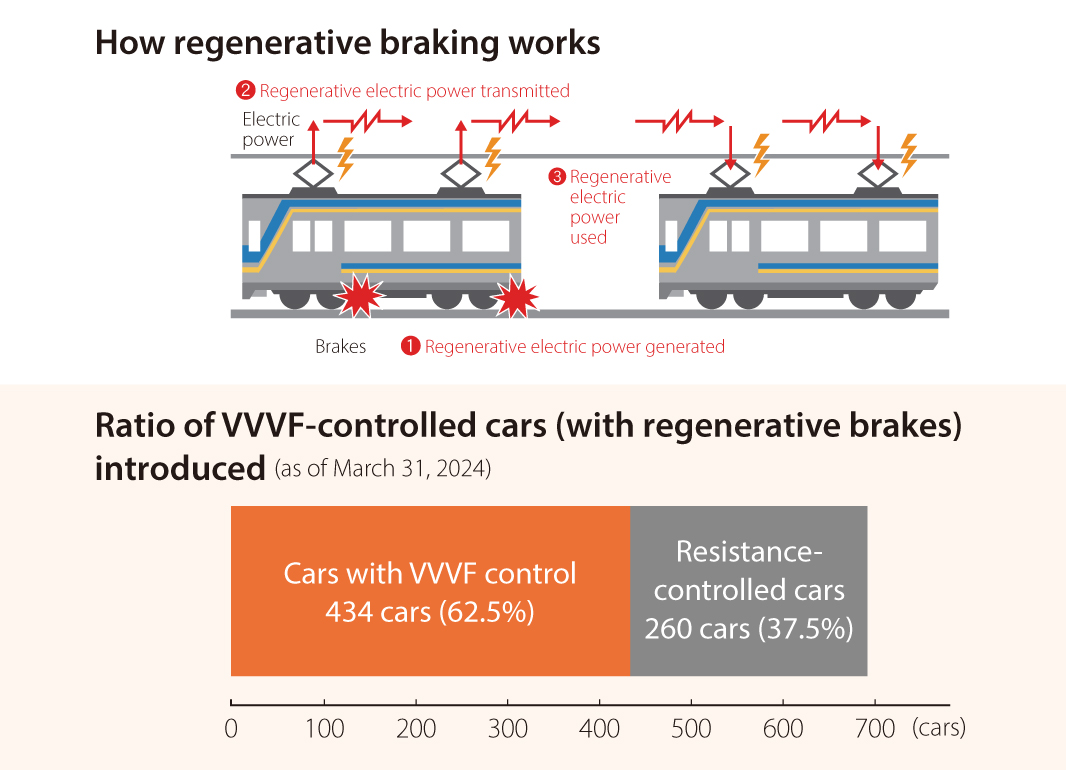
Adopting a collective power supply system for both incoming and outgoing lines, and phase capacitators to improve power factor
By connecting the power supply lines (to trains) for outgoing and incoming lines, we have reduced power supply resistance, which in turn reduces power losses from power lines. This allows regenerated current from regenerative brakes to run through the connection point, allowing outgoing and incoming trains to efficiently use the power to save the total power consumption. The use of phase capacitators to improve power factor also reduces power loss, improving power efficiency.
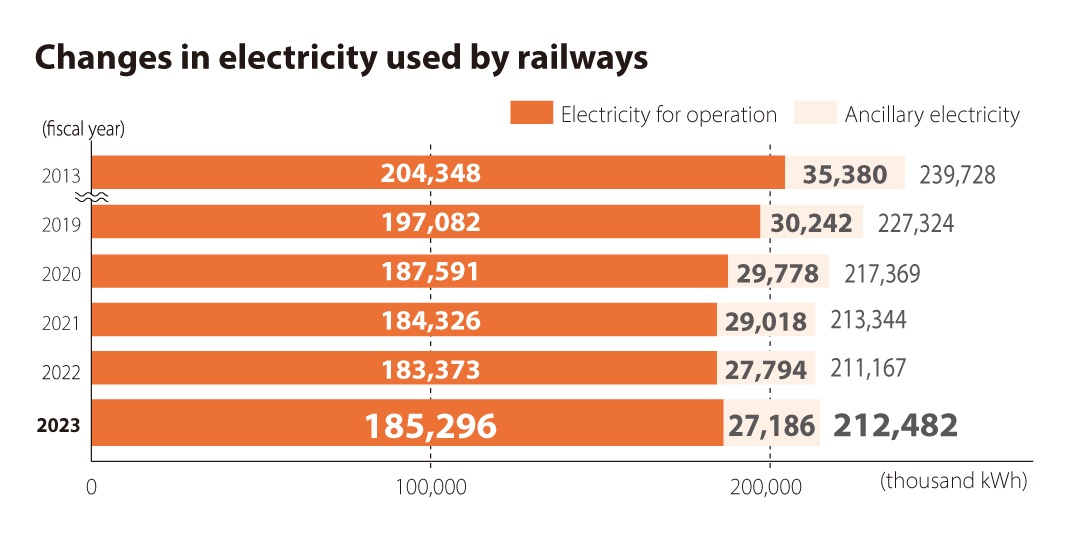
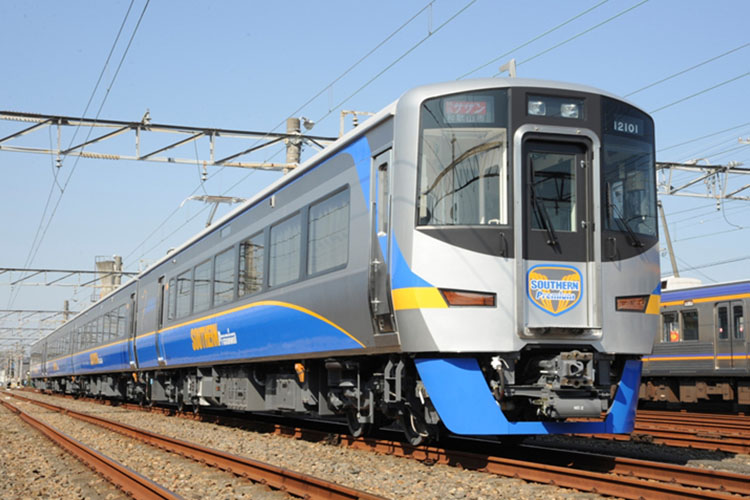
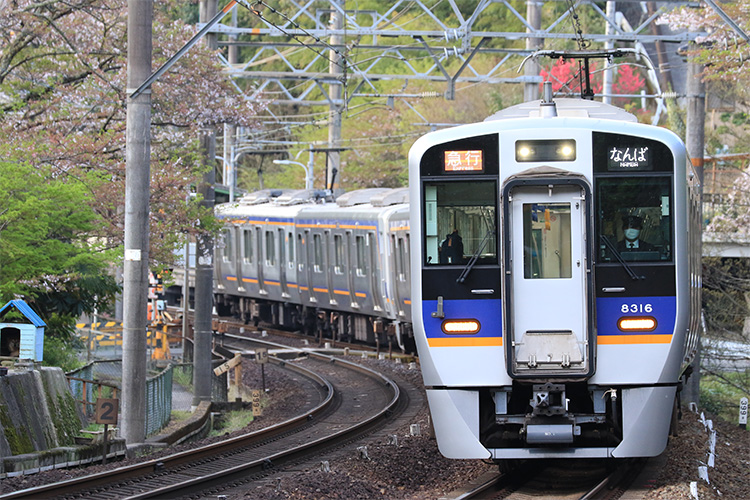
Energy conservation measures in real estate and distribution facilities
From FY2022 to FY2024, we plan to replace existing facilities with energy-saving equipment. Specifically, we are considering replacing heat source equipment that services the entire Nankai Terminal Building with equipment that is more efficient, and are also deliberating on the reduction of life-cycle costs by changing our equipment to the appropriate capacity and number of units according to the current load capacity. We are also considering cutting down on the electricity consumed by suppressing transporting power. This will be done by installing inverters that enable operation control according to the workload of pumps supplying cold water to all areas of large-scale facilities. Along with the renewal of these facilities, we also plan to automate equipment control, optimize operations, enable the visualization of these systems, and further cut down on energy consumption by installing heat source controllers and the Building Energy Management System (BEMS).
Operating environmentally friendly buses
In the bus business, three fuel-cell buses powered by hydrogen as an alternative energy source to light oil were introduced in FY2021 (two Tokushima buses and one Nankai bus), and two electric buses (Nankai bus) were introduced in FY2022 and are in operation.
Going forward, we will "contribute to preserving the global environment," reducing environmental stress, and aiming for the realization of a sustainable society.
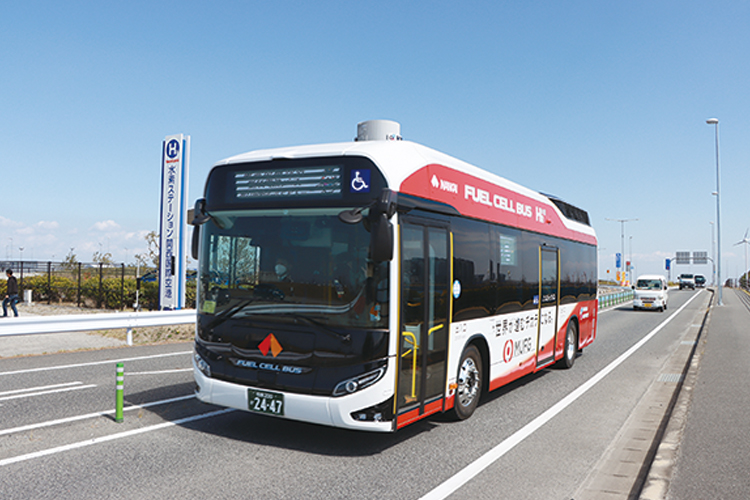
Utilizing renewable energy
As part of our efforts to promote CO2 emission reduction, we have been operating the Kosaku Line (Koyasan cable cars) on 100% renewable energy from June 2021. This initiative reduces CO2 emissions by approximately 60 tons per year.
Regarding the use of solar energy, solar power generation systems have been installed in areas such as platform awnings at Hagoromo Station, Izumiotsu Station, and Izumisano Station on the Nankai Line. Electricity generated by solar power is used to power those station facilities (lighting, air conditioning, elevators, etc.). In addition to the Tannowa Solar Power Plant (Misaki-cho, Sennan-gun, Osaka Prefecture) and Boat Race Suminoe (Suminoe-ku, Osaka City), which is owned by our group company Suminoe Kogyo Co., Ltd., we also installed new solar power generation equipment at Osaka Prefectural Food Products Distribution Center Building E (Ibaraki City, Osaka Prefecture), which is owned by Semboku Rapid Railway Co., Ltd., in April 2023. The entire group generates around 4 million kWh of electricity per year
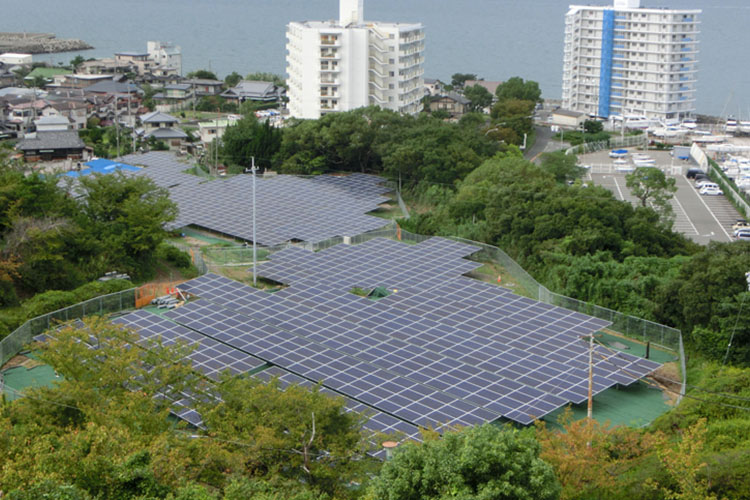
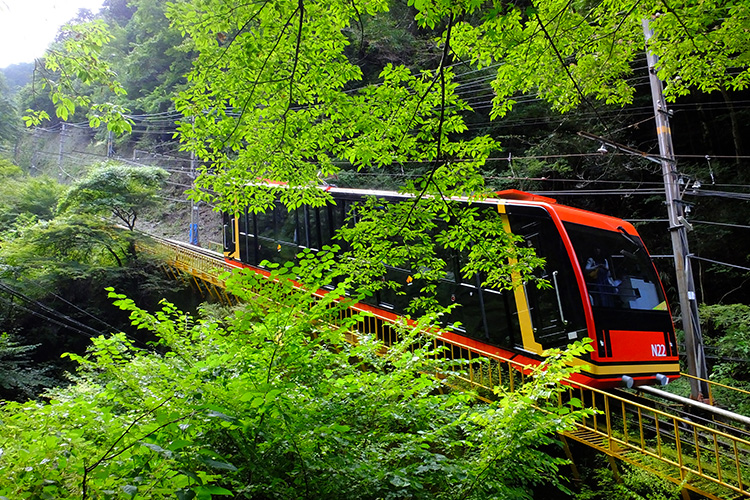
Expansion to the Limited Express Rapi:t
As part of our efforts to promote CO2 emission reduction, we have been running all six of our Limited Express Rapi:t trains on 100% renewable energy since April 2024 by applying Kansai Electric Power's Renewable Energy ECO Plan. This will reduce CO2 emissions by approximately 2,000 tons per year (about 2.6% of the CO2 emitted by railways).
The company will continue to consider and implement the use of new renewable energy.
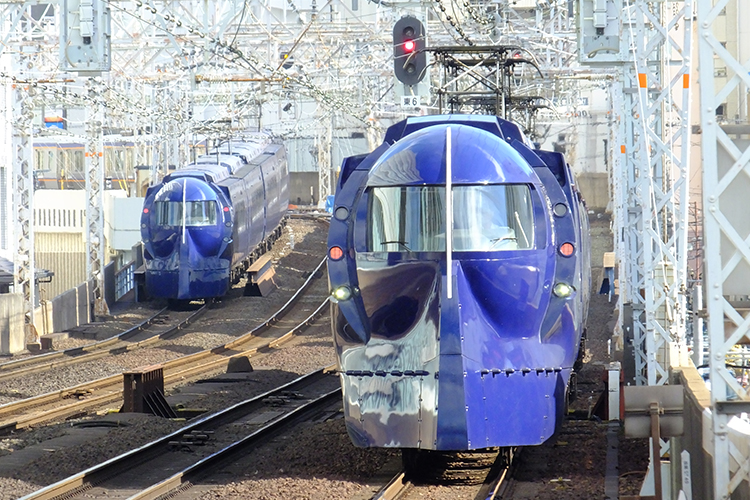
Promotion of Park & Ride
CO2 emissions by trains are only 1/5 that of private cars.* We are making efforts to reduce CO2 emissions by promoting the use of public transport with Park & Ride initiatives.
*Source: The Ministry of Land, Infrastructure, Transport and Tourism website (Carbon emissions in the transport sector 2022)
Registered as a ZEH developer
We are registered as a ZEH developer as designated by the Sustainable open Innovation Initiative.
*ZEH [net-zero energy house "(zecchi)"] are houses with greatly improved insulation in the outer walls that adopt efficient utility systems to maintain quality indoor environment and to save energy significantly, while introducing renewable energy to cancel out the primary annual energy consumption as net zero.
*A ZEH developer is a home owner (condominium developer, owner, etc.) or construction company (general constructor, home builder, and other constructors) who serves a central role in forming ZEH-M projects and in releasing the initiative plan to promote ZEH-M, its progress, the ZEH-M deployment plan, and the ZEH-M building record to the public based on the purpose of the ZEH verification project.
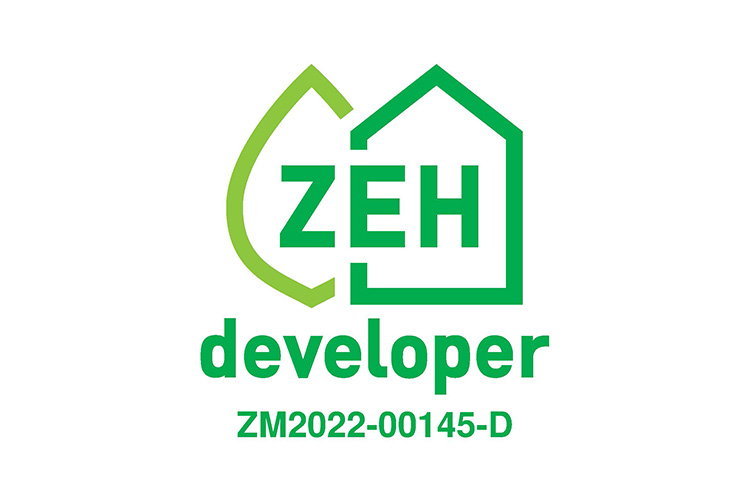
ZEH-M Introduction results
| Name of apartment building | Location | Completion date | ZEH-M rank |
|---|---|---|---|
| Southern Crest Namba Minami | Osaka City | Oct 2023 | ZEH-M Oriented |
Information disclosure by answering CDP
The Carbon Disclosure Project (CDP) is a partnership of institutional investors requesting that companies disclose their climate change strategies and details of their greenhouse gas emissions. We respond to CDP questionnaires on climate change and water every year.
| our company’s CDP score | 2019 | 2020 | 2021 | 2022 | 2023 |
|---|---|---|---|---|---|
| Climate change | B | B | B | B | A- |
| Water | B | B | B | B | C |
Agreeing to the national campaign of COOL CHOICE
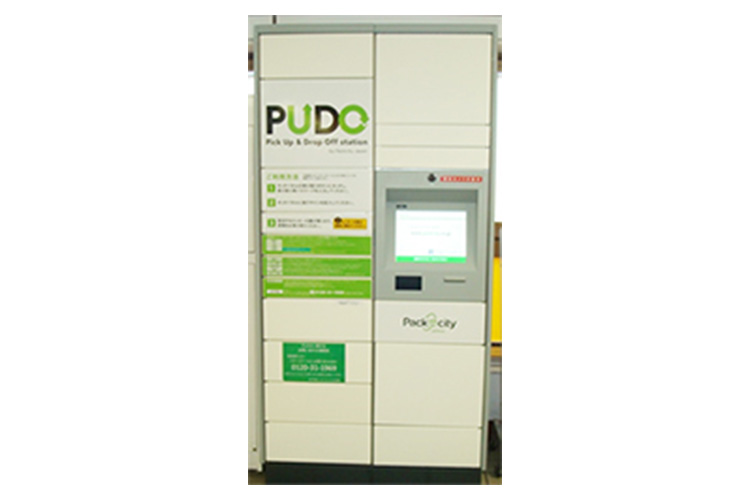
We have agreed to "COOL CHOICE (wise choice)," a national campaign endorsed by the government, and "COOL CHOICE - Campaign to Receive All Deliveries in One Go (project for all to stop re-deliveries)."
We are actively introducing specific measures, including installing delivery lockers at stations introducing energy-saving train cars, promoting park and ride, switching to LED lighting, and promoting green purchase.
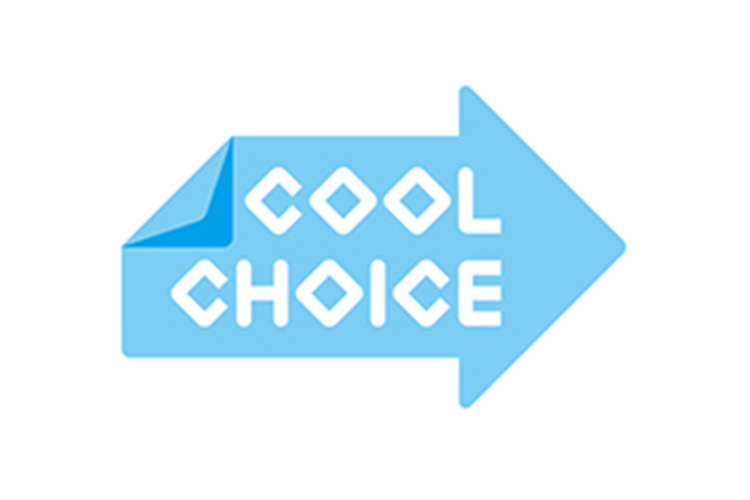
The Paris Agreement, an international framework for measures against global warming from 2020 onward, was adopted in 2015 with all countries participating. The aim was to limit the global temperature increase to below 2 degrees, make efforts to keep it at 1.5 degrees, and reduce net greenhouse gas emissions to zero in the last half of the century.
"COOL CHOICE" is an initiative to reduce greenhouse gas emissions that encourages people to make "wise choices" that contribute as measures against global warming, such as replacing products, using services, and adopting lifestyles that contribute to a decarbonized society.
Sustainability Site Map
(materiality)
- Major sustainability themes (materiality)
- Identification processes
- Further seek safety, security, and satisfaction
- Thriving and friendly community development
- Create a future full of dreams
- Achieve an enriched life
- Develop a workplace and staff in a way that enables each person to put their abilities to use
-
Contribute to preserving the global environment
- Environmental philosophy
- Reducing CO2 emissions in response to climate change, promoting the use of renewable energy, and so forth
- Bringing about a circular society
- Preserving biodiversity
- Deepening our environmental management
- Expanding environmental buildings (green buildings)
- Responses to TCFD Recommendations
- Bolster a corporate foundation that is sincere and fair
